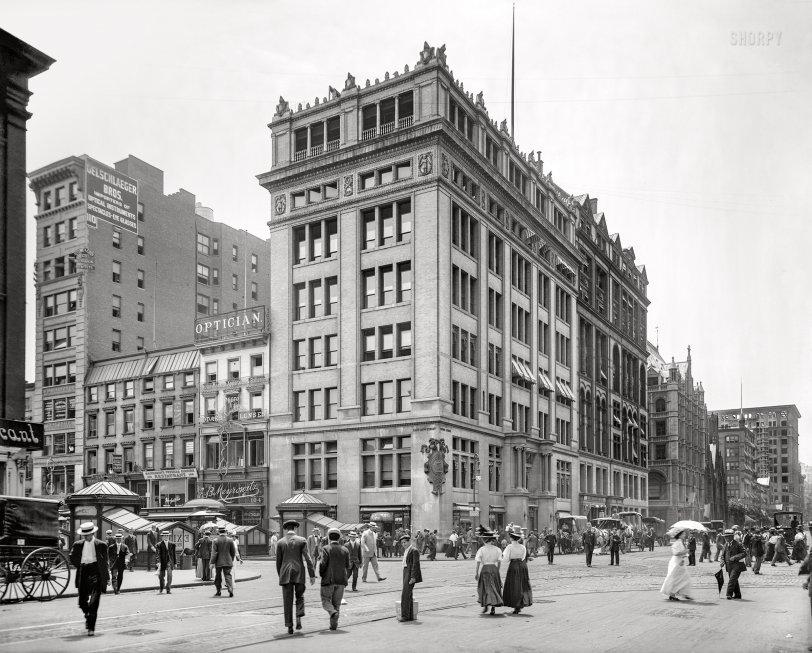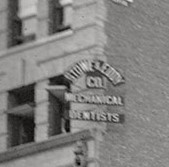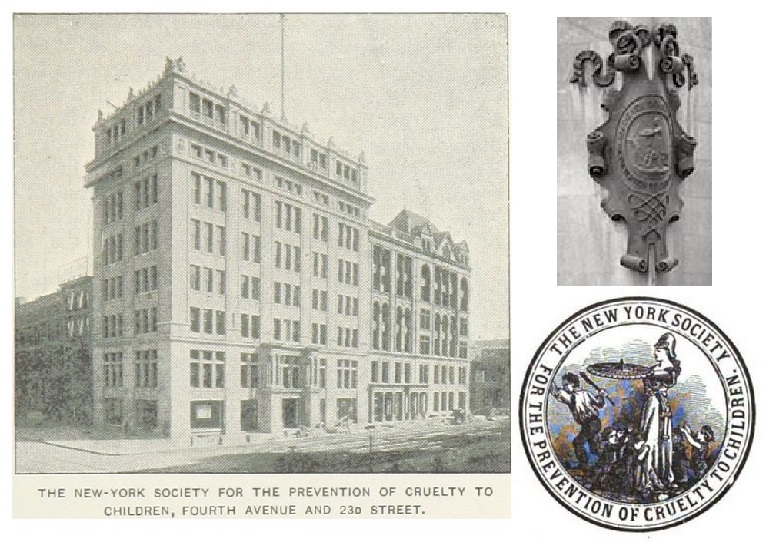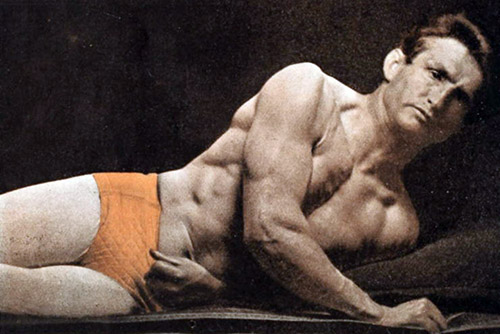


Framed or unframed, desk size to sofa size, printed by us in Arizona and Alabama since 2007. Explore now.
Shorpy is funded by you. Patreon contributors get an ad-free experience.
Learn more.

- Lofty addition
- In 1912
- Keenan Building
- Six years old
- Taken from the P.J. McArdle Roadway?
- It stood only 47 years
- Three track mind
- Incline to the right
- Reach for the sky, 1912 style
- No clean sweep
- Same Job Title, Same Face
- Sadly Lost
- Beautiful ...
- Where you get your kicks
- Aim High
- Pueblo Revival sisters
- Pueblo Neoclassicism
- Milk Man
- Regional dialect.
- Spielberg's inspiration
- Great Photo
- Loaf Story
- Do you still have the Rakes category?
- Could almost be a scene from the 1957 movie 'Hell Drivers'
- The Wages of Fear.
- Conspicuous by their absence
- Got Milk?
- All that aluminum
- No lefties
- Smoke 'em if you've got 'em
Print Emporium
NYSPCC: 1908

1908. "East Twenty-Third Street and Fourth Avenue." Anchored by the shelter of the New York Society for the Prevention of Cruelty to Children. 8x10 inch glass negative. View full size.
Dumbbells and Carrot Strips
was the title of McFadden's biography, written by his ex-wife Mary Williamson. In it, she accused him of being an authoritarian and a miser, claiming he only liked health culture because it was cheap.
Change of Address
Strictly speaking, there is no longer any such place as Fourth Avenue and 23rd Street, as most of Fourth was renamed Park Avenue South in 1959 (so much the better to sell real estate, my dear).
When were crosswalks invented?
It seems clear that they were still unknown in New York in 1908.
I found three sites that claimed the first crosswalks were instituted in the early 1900s, the 1930s, and the 1950s(!). So, I still don't know. Apparently you can't believe everything you read on the Internet.
Mechanical Dentist
The following was published circa 1900:
Besides the doctors of dentistry, there is the man known as the "mechanical dentist." He is really not a dentist at all, but a skilled mechanic who makes in his laboratory the artificial materials (such as crowns, bridges and plates) needed by the dental practitioner. The mechanical dentist need not be of so studious a nature as the doctor of dentistry, for his work requires chiefly manual skill. It is desirable that the mechanical dentist have the equivalent of a high school education. Then he must have practical training in the making of crowns, bridges, inlays, artificial teeth, and in the proper use of metals and other materials for this work.

NYSPCC: the logo
The 1893 (?) picture of the building, from the Mechanical Curator collection of the British Library, did not yet show the logo of the time. I found one on the cover of the Seventh Annual Report, I guess it is similar to the one on the building.

Still in Business
EB Meyrowitz still making some of the world's most expensive glasses. Bespoke if you may!
E.B. Myerowitz
Could Emil Bruno Myerowitz, born in 1852 in Prussia, have known that 112 years later there would still be a store on Old Bond Street in London, an active online bespoke business for eyeglasses, and an Instagram site? Names of various spectacle models include the New Yorker, the Atticus, the McQueen, the Sienna, the Sicilian, the Bostonian, the Brooklyn, and the Firenze.
Still mostly there
The space between the buildings has been filled with a 20th Century lifeless structure, but the rest is still there.
Must be summer
Everyone looks a little wilted, despite the straw hats and white shirtwaists. Lots of open windows and people leaning out. I love the giant spectacles. Oh look, the guy in the bow tie is on his cellphone.
Hat hierarchy
I'm interested in the distribution of hats seen in this picture. A ubiquity of straw boaters worn by the men on the left, kids (including newsies on the other side of the street) in flat caps, a few old-school black bowlers, the more elegant and lofty hats associated with specific professions (as worn by a cop and a chauffeur), and some stylishly-bedecked wide-brimmed hats worn by the identically-dressed women. To what extent were the various styles strictly associated with class? Or did age, subculture, personal predilection filter in as well?
Also note the chunky scaffolding on the nearly-completed building on the far right.
Probably had the same waitress
Macfadden's Restaurant reminds me of this place:
Meet me at Macfadden's Physical Culture Restaurant?
You couldn't make this up. Bernarr Macfadden (1868-1955) was an aggressive health advocate and the model for such as Jack LaLanne. He founded Physical Culture magazine as well as "healthatoriums" and a religion called "cosmotarianism." He was an advocate of bodybuilding, very long walks, recreational sex, and vegetarianism. He urged followers to avoid white bread and the medical profession. He expected to live to 150.
He also promoted week-long fasting. Just how that mixed with his restaurants is open to speculation.
(I doubt that the photo below was used to promote the restaurants--or the fasting, or the sex.)

Ahead Of Its Time
Macfadden’s Physical Culture Restaurant must have been seen as a kooky polar opposite of dining at Delmonico's. It was one of the earliest outlets devoted to vegetarian "healthy" eating in the city, and clearly (way, way) ahead of its time in 1908. Bernard Macfadden made a life out of promoting healthy eating, living and at all costs avoiding the consumption of white bread. There may not be a long line outside in this photo, but his idea for eats would not seem at all out of place in the same locale, circa 2020. He lived to be a ripe (for then) 87 years of age.
























On Shorpy:
Today’s Top 5